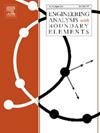用于 SMA 几何非线性问题分析的改进型径向基重现核粒子法
IF 4.2
2区 工程技术
Q1 ENGINEERING, MULTIDISCIPLINARY
Engineering Analysis with Boundary Elements
Pub Date : 2024-10-11
DOI:10.1016/j.enganabound.2024.105990
引用次数: 0
摘要
本文在径向基重现核粒子法(RRKPM)中使用了无整形参数的径向基函数(RBF),并提出了改进的径向基重现核粒子法(IRRKPM)。与传统的 RKPM 相比,IRRKPM 有效地减少了不同核函数对计算精度的影响,并进一步用于研究与形状记忆合金 (SMA) 相关的几何非线性问题。在 IRRKPM 框架内,通过惩罚函数法强制执行位移边界条件,同时利用弱形式的 Galerkin 积分法和总拉格朗日 (TL) 方法推导出 SMA 的几何非线性方程。然后使用牛顿-拉斐尔森(N-R)迭代法求解平衡方程。分析了不同的惩罚因子和影响域半径控制参数对误差的影响,比较了 IRRKPM 与 RRKPM 的计算精度,并评估了计算稳定性。最后,通过具体的数值示例证实了 IRRKPM 适用于分析 SMA 中的几何非线性问题。本文章由计算机程序翻译,如有差异,请以英文原文为准。
An improved radial basis reproducing kernel particle method for geometrically nonlinear problem analysis of SMAs
In this paper, the radial basis function (RBF) without shaped parameter is utilized in the radial basis reproducing kernel particle method (RRKPM), and an improved radial basis reproducing kernel particle method (IRRKPM) is proposed. Compared with traditional RKPM, the IRRKPM effectively reduces the impact of different kernel functions on calculation precision, and is further employed to examine geometrically nonlinear problems associated with shape memory alloys (SMAs). The displacement boundary condition is enforced via the penalty function method, while the Galerkin integration method in its weak form, along with the total Lagrangian (TL) approach, is utilized to derive the geometrically nonlinear equations for SMAs within the IRRKPM framework. The equilibrium equations are then solved using the Newton Raphson (N-R) iterative method. The impact of the different penalty factor and the radius control parameter of influence domain on errors is analyzed, the computational precision of the IRRKPM is compared with the RRKPM, and the computational stability is evaluated. Finally, the suitability of the IRRKPM for the analysis of geometrically nonlinearity problems in SMAs are confirmed through specific numerical examples.
求助全文
通过发布文献求助,成功后即可免费获取论文全文。
去求助
来源期刊

Engineering Analysis with Boundary Elements
工程技术-工程:综合
CiteScore
5.50
自引率
18.20%
发文量
368
审稿时长
56 days
期刊介绍:
This journal is specifically dedicated to the dissemination of the latest developments of new engineering analysis techniques using boundary elements and other mesh reduction methods.
Boundary element (BEM) and mesh reduction methods (MRM) are very active areas of research with the techniques being applied to solve increasingly complex problems. The journal stresses the importance of these applications as well as their computational aspects, reliability and robustness.
The main criteria for publication will be the originality of the work being reported, its potential usefulness and applications of the methods to new fields.
In addition to regular issues, the journal publishes a series of special issues dealing with specific areas of current research.
The journal has, for many years, provided a channel of communication between academics and industrial researchers working in mesh reduction methods
Fields Covered:
• Boundary Element Methods (BEM)
• Mesh Reduction Methods (MRM)
• Meshless Methods
• Integral Equations
• Applications of BEM/MRM in Engineering
• Numerical Methods related to BEM/MRM
• Computational Techniques
• Combination of Different Methods
• Advanced Formulations.
 求助内容:
求助内容: 应助结果提醒方式:
应助结果提醒方式:


